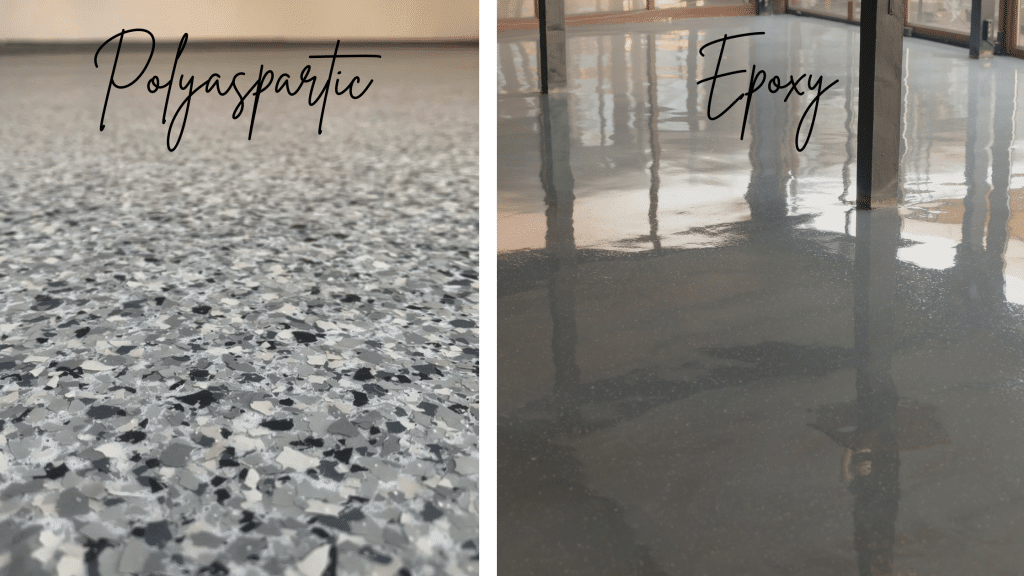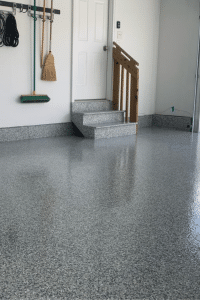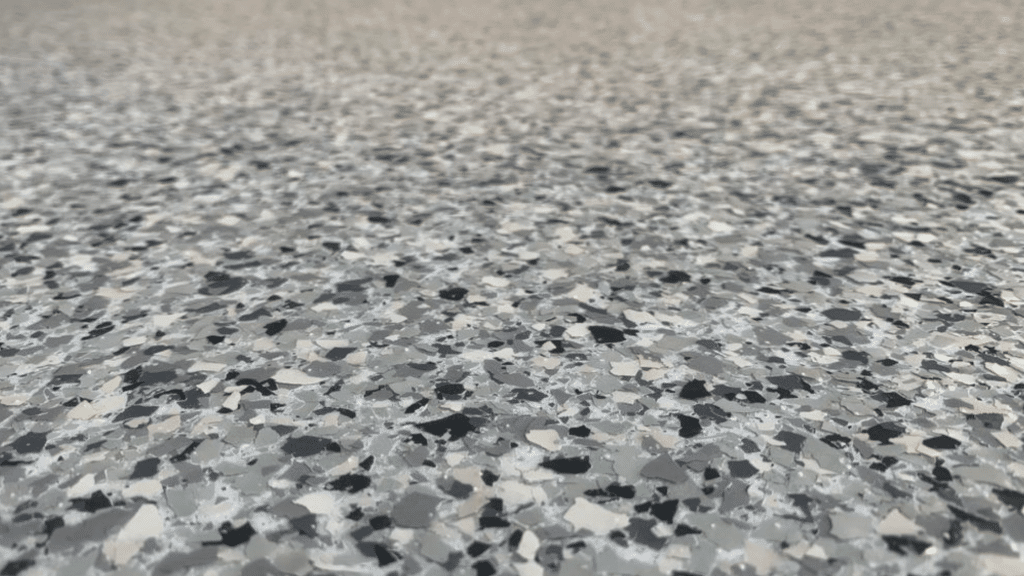
Step onto the canvas of your garage floor, where the ordinary beckons the extraordinary. Have you ever pondered the potential of your garage floor project to transcend the mundane? Whether you’re a weekend warrior surrounded by tools or a bustling family navigating daily chaos, your garage floor promises a makeover that transcends aesthetics. In the unfolding tale of coatings – epoxy and polyaspartic – discover the secrets behind gleaming surfaces, unraveling the nitty-gritty of protection, longevity, and a dash of garage magic. Join us on this transformative journey, where your garage floor project becomes not just a task but a statement of style and resilience.
Polyaspartic vs. Epoxy Durability Comparison
Polyaspartic vs. epoxy durability comparison in a garage floor project context is crucial, given the substantial wear that a typical garage floor experiences throughout its lifespan. Foot traffic is notably high, especially with an increasing number of homeowners using the garage as their primary entry point into their homes. Frequent movements in and out of the garage occur, mainly when engaged in yard work.
Your garage might also serve as a play area for your kids or a dedicated workshop space. The floor bears the weight of storage boxes and bins dragged across the concrete floor. When choosing the right floor coating, consider which coating polyaspartic vs. epxoy adds layers of protection. This is a crucial step for your garage floor project. Of course, nothing contributes more to wear and tear on your garage floor than the continuous comings and goings of vehicles, not to mention the act of parking itself, emphasizing the critical role of durability in your garage floor project. The durability of a garage floor becomes paramount to withstand the demands imposed by these various activities.
Why Polyaspartic Coatings Excel in Stress Resistance
Due to stress resistance on concrete floors due to temperature fluctuations, polyaspartic takes the lead compared to epoxy, making it a top choice for your garage floor project. The impact of shifting temperatures is far less pronounced on polyaspartic coatings, unlike epoxy, which struggles to adapt to temperature changes, leading to cracks and the dreaded delamination – a phenomenon where the coating lifts, chips, and peels, posing challenges to the success of your coating.
Investing in a high-quality polyaspartic floor coating for your garage floor project is akin to securing a decade or more of robust protection. In contrast, budget-friendly epoxy coatings often demand a complete re-application after a few years, which adds a layer of maintenance to your garage floor project.

Moreover, the typically thin layer left by epoxy coatings on a concrete surface wears down faster from the rigors of vehicle traffic and footprints, emphasizing the importance of choosing the right coating for your garage floor project. In the endurance race against general wear and tear, polyaspartic coatings emerge as the long-lasting champions, ensuring your garage floor remains resilient and visually appealing throughout its lifespan.
Exploring Flexibility: Why It Matters in Garage Floor Project
Concrete, aside from being porous, possesses a surprising level of flexibility. But why does this matter when selecting a floor coating? The flexibility of a concrete garage floor becomes crucial due to its need to accommodate the inevitable expansion and contraction caused by temperature variations, making it a significant consideration for your garage floor project.
Polyaspartic offers great flexibility tailored for your garage floor project. Unlike epoxy, which tends to be more brittle, polyaspartic exhibits superior elasticity. How much better, you ask? A substantial amount. Premium polyaspartic coatings boast an elasticity that surpasses epoxy by a remarkable 98-100%. This flexibility isn’t just a feature; it must ensure your floor coating can gracefully handle the thermal fluctuations it encounters.
UV Stability and Color Stability Comparison
In terms of UV stability and color retention, polyaspartic floors surpass epoxy, making them the superior choice for your garage floor project. The top coat of a polyaspartic floor remains resilient against discoloration and loss of high-gloss appearance, even under direct sunlight. This is a common issue with epoxy-coated floors. Epoxy lacks inherent UV protection, leaving it vulnerable to sun-induced damage, a notable concern for garage floors frequently exposed to sunlight. While some epoxies integrate UV inhibitors, their protective capabilities fall short compared to the robust shield provided by polyaspartic coatings, ensuring longevity, color vibrancy, and gloss retention in your garage floor project.

The significance of a resilient top coat is evident in the comparison of polyaspartic vs. epoxy coatings for garage floor projects. The top coat of a polyaspartic floor exhibits remarkable resilience, maintaining color and high-gloss allure even with prolonged exposure to sunlight. The vulnerability of epoxy to UV rays becomes a substantial concern for garage floors, making polyaspartic the reliable champion in preserving the color and shielding against the sunlight for your garage floor project.
How Well Do Epoxy vs. Polyaspartic Coatings Seal Garage Floors
Sealing the deal on your garage floor project is crucial. Epoxy coatings offer a solid seal, but polyaspartic coatings take it up a notch, providing an enhanced solution for your garage floor project. With a rapid cure time, polyaspartic coatings ensure a swift and effective seal, minimizing downtime for your garage floor project. Say goodbye to long waiting periods. A protected garage floor in no time makes polyaspartic coatings the ideal choice for your garage floor project.
What Is the Most Affordable Garage Floor Coating
As budget considerations play a role in your garage floor project, affordability becomes crucial. Epoxy coatings are generally more budget-friendly upfront due to lower manufacturing costs, making them a tempting choice for your garage floor project. However, delving more deeply, a professional polyaspartic floor coating application proves its worth for your garage floor project. A high-quality polyaspartic floor coating outshines any epoxy in aesthetics and performance, providing exceptional value for your garage floor project. So, while epoxy may appear more cost-effective initially in your garage floor project, the long-term benefits of a polyaspartic floor coating make it a wise investment in your garage floor’s lasting beauty and resilience for your garage floor project.
Opting for a DIY installation may seem cost-effective, yet it may not be the wisest choice, especially for beginners aiming for a swift, efficient, and well-executed process. Entrusting the task to a skilled professional contractor is recommended to ensure a seamless and hassle-free experience.
The Right Floor Coating for Your Project
Both contenders have their merits in deciding which ones could be the right coating for your garage floor project. Polyaspartic coatings shine in terms of longevity, sealing efficiency, flexibility, UV stability, and long-term affordability.
Whether you’re revamping your home, commercial space, or industrial facility, our team of experts can help you choose the best for any project. Our options allow customization of nearly any surface without compromising functionality. HelloProject will match you with a professional floor installer near you to protect or add style to your garage flooring space! Ultimately, the best coating depends on your specific needs and priorities. So, what’s it going to be for your garage?
